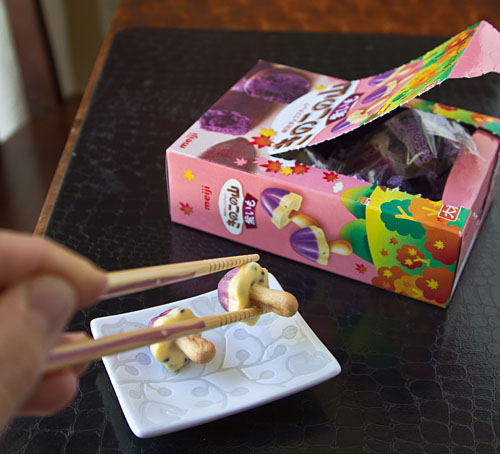Podcast: Play in new window | Download (Duration: 30:42 — 28.1MB)
Have you entered our Zojirushi rice cooker giveaway yet? If not, don’t forget to head on over and enter… the contest ends tomorrow!

Chopsticks are called hashi in Japanese. They are also known as otemoto or o-temoto, a phrase which is commonly printed on the wrappers of disposable chopsticks. “Te” means hand and “moto” means the area under or around something.
Chopsticks are a pair of long stick-like implements, most commonly made of wood, bamboo, or plastic (though they can also be made of metal, bone, or ivory). Hashi are held in the dominant hand and used to to grab and pick up your food (don’t stab your food with them!)
Japanese hashi are shorter length sticks (in comparison to those used in other countries), tapering to a finely pointed end. Japanese chopsticks are traditionally made of wood or bamboo and are lacquered. It is common for Japanese sticks to be of shorter length for women. Children’s chopsticks, which are much smaller than adult-sized chopsticks, are also common… as are “trainer” chopsticks, like these:

There is also a way to make “trainer” chopsticks out of the disposable wooden chopsticks that you find at most Asian restaurants. Rachael made a handy video showing how to make them:
Hashi History
Hashi have been around for a very long time. They are generally believed to have originated in ancient China. They are also found in some areas of Tibet and Nepal that are close to Han Chinese populations, as well as areas of Thailand, Laos, and Burma which have significant Chinese populations.
Hashi has been found in ancient China as early as the Shang dynasty (1766-1122 BC). The earliest evidence of a pair of hashi, made of bronze, were dated to be roughly from 1200 BC.
The first hashi were probably used for cooking, stirring the fire, serving or seizing bits of food, and not as eating utensils.
Hashi began to be used as eating utensils during the Han Dynasty. Japan has had hashi as part of their traditional eating utensils for thousands of years.
Hashi Varieties
- Waribashi (割り箸) are those wooden chopsticks that you need to break apart.
- “My Hashi” are reusable chopstics are known as my hashi, meaning “my chopsticks”. These are hashi that you carry around with you, as your personal chopsticks that you use instead of waribashi.
- Saibashi (cooking chopsticks) are recognizeable by their length, and are used for both cooking and arranging food for the table. The longer the chopsticks, the farther away from the stove you can be, making saibashi wonderful for grasping, flipping, poking, stirring, etc. Saibashi can be used in lieu of tongs or a spatula, etc.
When blanching foods, saibashi permit you to remove just one piece from the hot water to test for doneness.
When foods are done, saibashi allow you to pluck out all of them, avoiding the need to drain the pot. This means you can use the same pot of boiling water to blanch several foods in succession.
You can use saibashi to place, stack, and coax foods into mounds on a plate for serving.
Hashi How-To
With the proper hand position and a little practice, you too can learn to eat with chopsticks!
Hold the thick end of one chopstick between the base of your thumb and your hand. Rest the thin end on the tips of your last two fingers, which should be slightly curved. This chopstick will stay still.
Then take the other chopstick and hold it between the tips of your first two fingers and tip of your thumb. Curve your fingers.
To pick something up, move the top chopstick up and down.
Hashi Hilarity
So… we’re sure you’re wondering now, what happens when you take waribashi to a food blogger conference, and ask people to eat their lunch with them? Of course, we had to find out. So off we went to Camp Blogaway a few weeks ago, waribashi and iPhone camera in hand:
Big thanks to Lynne Hermer, Dara Michalski, Becky Spenser, Deb McGrath, Leslie Macchiarella, Shawn Syphus, Natalie Wiser-Orozco, Gerry Spears, Cathy Arkle, Rene Lynch, Nathan Haynes, Carolyn Ketchum, Stacy Spensley, Barbara McGlone, Greg Henry, Gisele Perez, Sarah Glyer, Benjamin Rhau, Kelly Jaggers, and of course Scharffen Berger Chocolate for being an awesome Camp Blogaway sponsor and making a cameo in our video!
